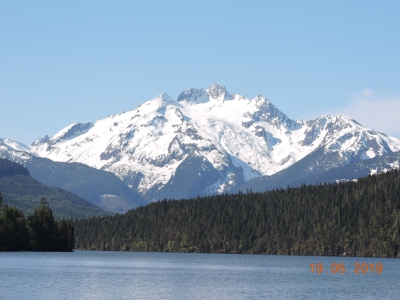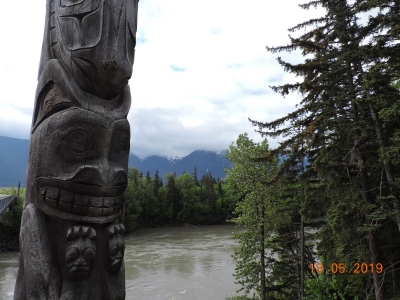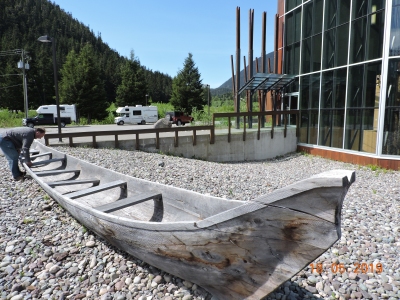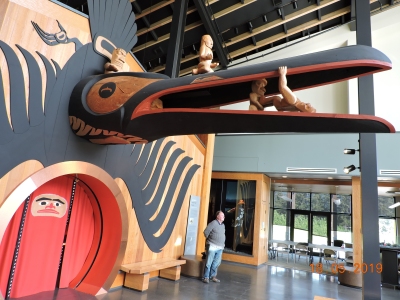North in the Spring: #19:
Tseax Volcano by John Neville 
 About two and a half centuries ago (1750-1775) a
volcanic eruption took place in B.C. The Tseax Cone
(also known as the Aiyansh Volcano) exploded, pouring
molten lava down its slope into the Nass River. The lava
flow is about 12 km long. Originally, it almost blocked the
Nass River. It may have been the worst natural disaster
in Canadian history because it is estimated that at least
2,000 Nisga'a people were killed by the poisonous gases.
If you visit Nisga'a Memorial Lava Bed Provincial Park
(Anhluut'ukwsim Laxmihl Angwinga'a sanskwhl Nisga'a),
you will be asked to not remove rocks or stones as they
are respected as the tombstones of the Nisga'a ancestors.
https://bit.ly/3Ge33Na
About two and a half centuries ago (1750-1775) a
volcanic eruption took place in B.C. The Tseax Cone
(also known as the Aiyansh Volcano) exploded, pouring
molten lava down its slope into the Nass River. The lava
flow is about 12 km long. Originally, it almost blocked the
Nass River. It may have been the worst natural disaster
in Canadian history because it is estimated that at least
2,000 Nisga'a people were killed by the poisonous gases.
If you visit Nisga'a Memorial Lava Bed Provincial Park
(Anhluut'ukwsim Laxmihl Angwinga'a sanskwhl Nisga'a),
you will be asked to not remove rocks or stones as they
are respected as the tombstones of the Nisga'a ancestors.
https://bit.ly/3Ge33Na
 The total area covered by the lava flow is 39-square.kilometres and in some places is 12-metres thick. The hot
lava not only swallowed up many trees but also set them
on fire. As the lava cooled it left perfect "casts" of tree
trunks behind, including the features of the bark. Cinder
cones are created when gas- charged lava explodes out of
volcanic vents. The pieces of lava cool in mid-air and land
as cinders around the vents. One cone stands 100-metres
high and has a crater 80-metres deep.
The total area covered by the lava flow is 39-square.kilometres and in some places is 12-metres thick. The hot
lava not only swallowed up many trees but also set them
on fire. As the lava cooled it left perfect "casts" of tree
trunks behind, including the features of the bark. Cinder
cones are created when gas- charged lava explodes out of
volcanic vents. The pieces of lava cool in mid-air and land
as cinders around the vents. One cone stands 100-metres
high and has a crater 80-metres deep.
 The lava flow isolated five kilometres of Vedder Creek from
the Tseax River and the Steelhead trapped in the creek
gradually evolved into what are known as "phantom" fish
with snake-like bodies with large heads. We were unable
to find any fish when we walked the trail. Due to the rocky
surface, nature is only now re-establishing itself on the lava.
Many of the trees are more than a century old but less than
a metre in height.
The lava flow isolated five kilometres of Vedder Creek from
the Tseax River and the Steelhead trapped in the creek
gradually evolved into what are known as "phantom" fish
with snake-like bodies with large heads. We were unable
to find any fish when we walked the trail. Due to the rocky
surface, nature is only now re-establishing itself on the lava.
Many of the trees are more than a century old but less than
a metre in height.
Since the signing of the Nisga'a Treaty in 2000 there have been some infrastructure improvements. For example: we crossed the river in earlier times on a very shaky rope suspension bridge in the village of Gitwinksihlkw (the Place of Lizards) on the bank of the Nass River; now there is a substantial concrete bridge and pedestrian walkway with totems representing the four clans at each corner.  A world-class museum has also recently been
established, allowing the Nisga'a Nation to display
their rich cultural heritage and many fine works of
art. The harmony of the people with nature and the
respect Nisga'a have for the world around them is fully
depicted. Our respect for the people was enhanced by
their code: "Be kind, generous and humorous."
To visit this incredible site, turn north at Terrace and
travel approximately 80 km on Hwy 113 into the Nass
Valley. This road is an ancient travelling corridor for
the Kitsum Kalum people: passing Kitsum Kalum, Sand,
Lava, and Gainer Lakes, with coastal mountains just off
to the west. https://www.nisgaanation.ca/volcano
A world-class museum has also recently been
established, allowing the Nisga'a Nation to display
their rich cultural heritage and many fine works of
art. The harmony of the people with nature and the
respect Nisga'a have for the world around them is fully
depicted. Our respect for the people was enhanced by
their code: "Be kind, generous and humorous."
To visit this incredible site, turn north at Terrace and
travel approximately 80 km on Hwy 113 into the Nass
Valley. This road is an ancient travelling corridor for
the Kitsum Kalum people: passing Kitsum Kalum, Sand,
Lava, and Gainer Lakes, with coastal mountains just off
to the west. https://www.nisgaanation.ca/volcano
Enjoy this article featured on page 31 of the Spring 2022 edition of BC Nature |